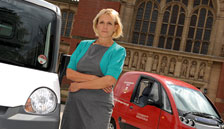The University of Birmingham is a trailblazer on fleet strategy and initiatives among its higher education peer group.
The first university to centralise its fleet function, and still one of just a handful to do so, it is now spearheading research into electric and hydrogen fuel cell vehicles.
The birthplace of an alternative way to cook food – the magnetron, a key component on the microwave, was developed there – is now at the forefront of alternative fuels with the pioneering work carried out by Professor Kevin Kendall (see panel).
Those vehicles sit outside the main fleet, procured and maintained by Kendall’s engineering and physical sciences department. However, they undertake a similar role to other on-site vehicles as postal vehicles which enables the university to compare performance with diesel versions.
The centralised fleet service is an interesting deviation from the traditional university set up. Most institutions allow individual departments to procure and manage their own vehicles with few controls or consistency on costs, maintenance and safety.
The University of Birmingham has always centralised its transport function and is increasingly acting as a guiding light to other higher education faculties considering merging their fleet operations.
“We offer a bespoke service to each department – we charge the vehicles out to them but we control everything centrally,” says Monica Guise.
She added fleet duties to her postal and portering role last year when the previous transport manager retired after 49 years of managing the fleet.
“I visit a lot of other universities and they are coming here to see what we do and how we do it. I expect others will introduce similar policies.”
Guise had four main challenges when she took on fleet: accidents, business systems, vehicle hire and driver responsibility.
The University’s 120-strong job-need fleet of cars, gritters, mowers, JCBs, bippers and a 7.5-tonne tail-lift suffered a lot of accident damage, mostly low speed impacts such as reversing knocks.
Three qualified assessors appraised the 500 or so drivers for occupational road risk. Licences are now checked once a year while all vehicles have been fitted with parking sensors.
Guise also started involving each department and its drivers when vehicles were due to be replaced by organising demonstrators and letting them have a say in the decision.
It made them feel part of the process which in turn made them more accountable for vehicle care.
In some instances she has allocated a vehicle to a named driver to make them more responsible for its upkeep.
Anyone involved in an accident is reassessed; some are sent on driver training with RoSPA.
Anyone deemed not capable of driving safely will be removed from the list.
The accident rate has fallen by 40% in just one year; Guise anticipates a big reduction in her insurance premiums as a result.
Next year she will bring training in-house by up-skilling the assessors.
In addition to employees, Guise also has to manage the student mini-bus service. Students used to undergo a half-day course before being allowed to drive a university mini-bus; now they have to take a test. Up to 30% fail.
“This has seen a massive fall in claims that we put through the student guilds,” she says.
Minibus and car hire booking are being put online to simplify the administration.
Guise is presently phasing in a 10-year strategy to switch the university’s funding method from contract hire to outright purchase.
With its vehicles averaging 6,000 miles a year on a four-year replacement cycle, leasing is not the most financially viable option.













Login to comment
Comments
No comments have been made yet.